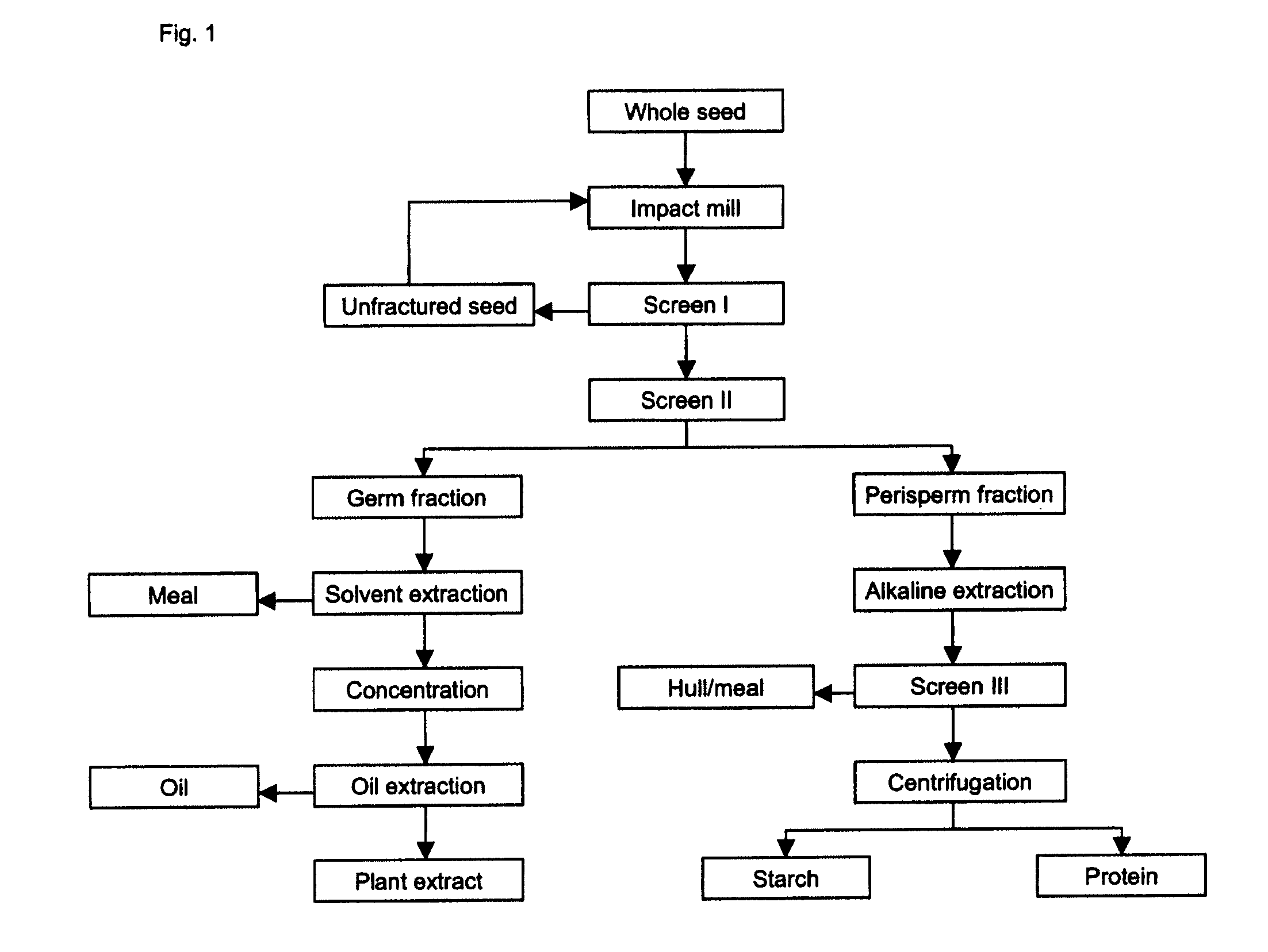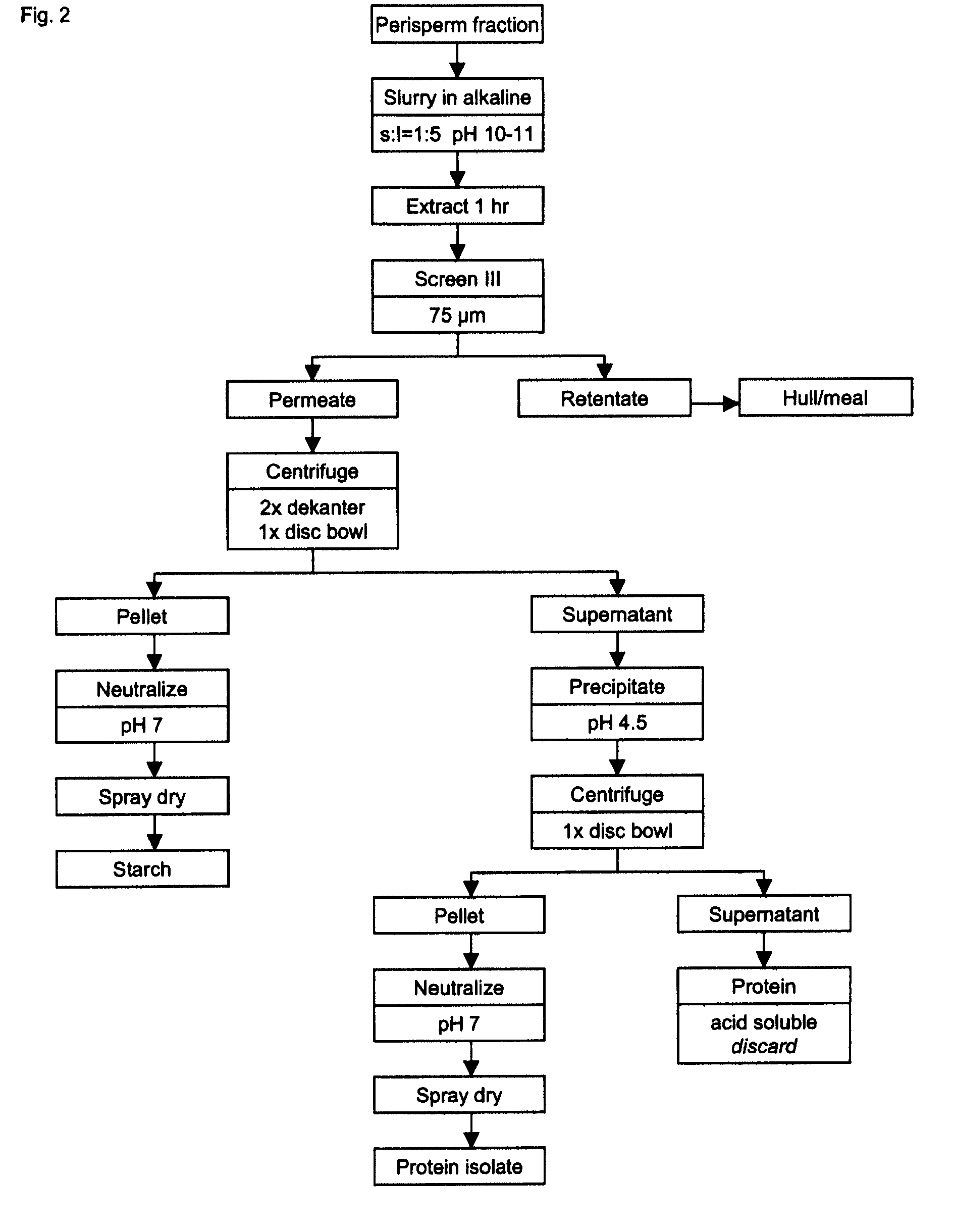Process for seed and grain fractionation and recovery of bio-products
a technology of bio-products and fractionation, which is applied in the field of seed and grain processing, can solve the problems of inability to develop comprehensive milling and fractionation procedures for a new species, inability to effectively separate particles smaller than 5 m, and inability to meet the requirements of a large-scale production and processing process, so as to reduce processing times and reduce solvent volume. , the effect of enhancing the commercial viability and environmental responsibility of the process
- Summary
- Abstract
- Description
- Claims
- Application Information
AI Technical Summary
Benefits of technology
Problems solved by technology
Method used
Image
Examples
example 1
Fractionation of Saponaria vaccaria Seed by Impact Milling
[0098]Saponaria vaccaria seed was harvested mechanically from field grown plants and cleaned by screening and air classification to remove debris and any foreign seeds.
[0099]The seed was tempered to a seed moisture content of 12% for 18 hours. The tempered whole seed was milled using an impact mill (Type SER 14 S, Entoleter) at a mill speed of 3260 rpm.
[0100]Non-fractured seed was recovered by screening using a screen with a pore size of 1.7 mm. Any material larger than 1.7 mm is intact whole seed which is re-fed through the mill, while the fractured seed passes through the screen. The fractured seed is further screened through a 1 mm screen. The fraction with a particle size larger than 1 mm contains primarily the starch rich perisperm with attached hull fragments. The fraction with a particle size smaller than 1 mm is predominantly whole and fractured germ as well as loose hull material.
[0101]The whole seed fractionation pr...
example 2
Preparation of Saponaria vaccaria Starch from the Perisperm Fraction on a Laboratory Scale
[0102]200 mL 0.03% sodium hydroxide solution was added to 40 g of the perisperm fraction (as provided in Example 1) and stirred for one hour at medium speed. The pH was adjusted to pH 10 using concentrated sodium hydroxide. The resultant material was passed though a US standard screen No. 500 (25 μm pore size) and the retentate discarded. The permeate was centrifuged at 4000 rpm (1252 g) for 10 minutes in a basket centrifuge (Model 5810R, Eppendorf). The supernatant containing the solubilized protein was discarded. The starch pellet was dispersed in 200 mL water, brought to pH 7 using concentrated hydrochloric acid and centrifuged at 4000 rpm (1252 g) for an additional 10 minutes. The supernatant was discarded. The starch pellet was dispersed in 100 mL 95% ethanol and centrifuged at 4000 rpm (1252 g) for 10 minutes. The supernatant was discarded and the starch was air dried.
[0103]Approximately ...
example 3
Preparation of Saponaria vaccaria Seed Extract from the Germ Fraction on a Laboratory Scale
[0104]A 60 gram sample of the germ fraction was extracted with 300 mL of 70% (v / v) methanol in water at a temperature of 60° C. in three steps of an hour each. The extraction was done in a waterbath and the sample was shaken vigorously every 15 minutes. After the first extraction interval the sample was centrifuged for 15 minutes at 4000 rpm (1252 g). The supernatant was poured off and 300 mL of fresh solvent (70% v / v methanol in water) was added to the pellet.
[0105]The pellet was extracted at a temperature of 60° C. in a waterbath and the sample was shaken vigorously every 15 minutes. After the second extraction interval the sample was centrifuged for 15 minutes at 4000 rpm (1252 g). The supernatant was poured off and combined with the supernatant of the first extraction step.
[0106]A third 300 mL of fresh solvent (70% v / v methanol in water) was added to the pellet. The pellet was extracted at...
PUM
 Login to View More
Login to View More Abstract
Description
Claims
Application Information
 Login to View More
Login to View More - R&D
- Intellectual Property
- Life Sciences
- Materials
- Tech Scout
- Unparalleled Data Quality
- Higher Quality Content
- 60% Fewer Hallucinations
Browse by: Latest US Patents, China's latest patents, Technical Efficacy Thesaurus, Application Domain, Technology Topic, Popular Technical Reports.
© 2025 PatSnap. All rights reserved.Legal|Privacy policy|Modern Slavery Act Transparency Statement|Sitemap|About US| Contact US: help@patsnap.com


